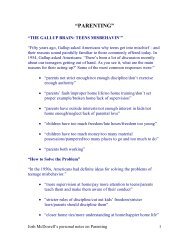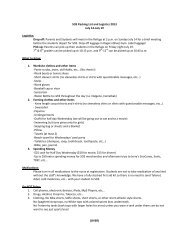Pdf Copy of Orthodoxy, by G.K. Chesterton - Christ United Methodist ...
Pdf Copy of Orthodoxy, by G.K. Chesterton - Christ United Methodist ...
Pdf Copy of Orthodoxy, by G.K. Chesterton - Christ United Methodist ...
Create successful ePaper yourself
Turn your PDF publications into a flip-book with our unique Google optimized e-Paper software.
9/ 27/ 12 The Pr oject G ut enber g eBook <strong>of</strong> O r t hodoxy, G . K. Chest er t on<br />
www. gut enber g. or g/ f iles/ 16769/ 16769- h/ 16769- h. ht m<br />
essential thing about it was that it was duplicate. A man is two men, he on the right exactly<br />
resembling him on the left. Having noted that there was an arm on the right and one on the<br />
left, a leg on the right and one on the left, he might go further and still find on each side the<br />
same number <strong>of</strong> fingers, the same number <strong>of</strong> toes, twin eyes, twin ears, twin nostrils, and<br />
even twin lobes <strong>of</strong> the brain. At last he would take it as a law; and then, where he found a<br />
heart on one side, would deduce that there was another heart on the other. And just then,<br />
where he most felt he was right, he would be wrong.<br />
It is this silent swerving from accuracy <strong>by</strong> an inch that is the uncanny element in everything. It<br />
seems a sort <strong>of</strong> secret treason in the universe. An apple or an orange is round enough to get<br />
itself called round, and yet is not round after all. The earth itself is shaped like an orange in<br />
order to lure some simple astronomer into calling it a globe. A blade <strong>of</strong> grass is called after<br />
the blade <strong>of</strong> a sword, because it comes to a point; but it doesn't. Everywhere in things there<br />
is this element <strong>of</strong> the quiet and incalculable. It escapes the rationalists, but it never escapes<br />
till the last moment. From the grand curve <strong>of</strong> our earth it could easily be inferred that every<br />
inch <strong>of</strong> it was thus curved. It would seem rational that as a man has a brain on both sides, he<br />
should have a heart on both sides. Yet scientific men are still organizing expeditions to find<br />
the North Pole, because they are so fond <strong>of</strong> flat country. Scientific men are also still<br />
organising expeditions to find a man's heart; and when they try to find it, they generally get<br />
on the wrong side <strong>of</strong> him.<br />
Now, actual insight or inspiration is best tested <strong>by</strong> whether it guesses these hidden<br />
malformations or surprises. If our mathematician from the moon saw the two arms and the<br />
two ears, he might deduce the two shoulder-blades and the two halves <strong>of</strong> the brain. But if he<br />
guessed that the man's heart was in the right place, then I should call him something more<br />
than a mathematician. Now, this is exactly the claim which I have since come to propound<br />
for <strong>Christ</strong>ianity. Not merely that it deduces logical truths, but that when it suddenly becomes<br />
illogical, it has found, so to speak, an illogical truth. It not only goes right about things, but it<br />
goes wrong (if one may say so) exactly where the things go wrong. Its plan suits the secret<br />
irregularities, and expects the unexpected. It is simple about the simple truth; but it is<br />
stubborn about the subtle truth. It will admit that a man has two hands, it will not admit<br />
(though all the Modernists wail to it) the obvious deduction that he has two hearts. It is my<br />
only purpose in this chapter to point this out; to show that whenever we feel there is<br />
something odd in <strong>Christ</strong>ian theology, we shall generally find that there is something odd in the<br />
truth.<br />
I have alluded to an unmeaning phrase to the effect that such and such a creed cannot be<br />
believed in our age. Of course, anything can be believed in any age. But, oddly enough,<br />
there really is a sense in which a creed, if it is believed at all, can be believed more fixedly in<br />
a complex society than in a simple one. If a man finds <strong>Christ</strong>ianity true in Birmingham, he has<br />
actually clearer reasons for faith than if he had found it true in Mercia. For the more<br />
complicated seems the coincidence, the less it can be a coincidence. If snowflakes fell in the<br />
shape, say, <strong>of</strong> the heart <strong>of</strong> Midlothian, it might be an accident. But if snowflakes fell in the<br />
exact shape <strong>of</strong> the maze at Hampton Court, I think one might call it a miracle. It is exactly as<br />
<strong>of</strong> such a miracle that I have since come to feel <strong>of</strong> the philosophy <strong>of</strong> <strong>Christ</strong>ianity. The<br />
complication <strong>of</strong> our modern world proves the truth <strong>of</strong> the creed more perfectly than any <strong>of</strong><br />
the plain problems <strong>of</strong> the ages <strong>of</strong> faith. It was in Notting Hill and Battersea that I began to<br />
46/ 100





